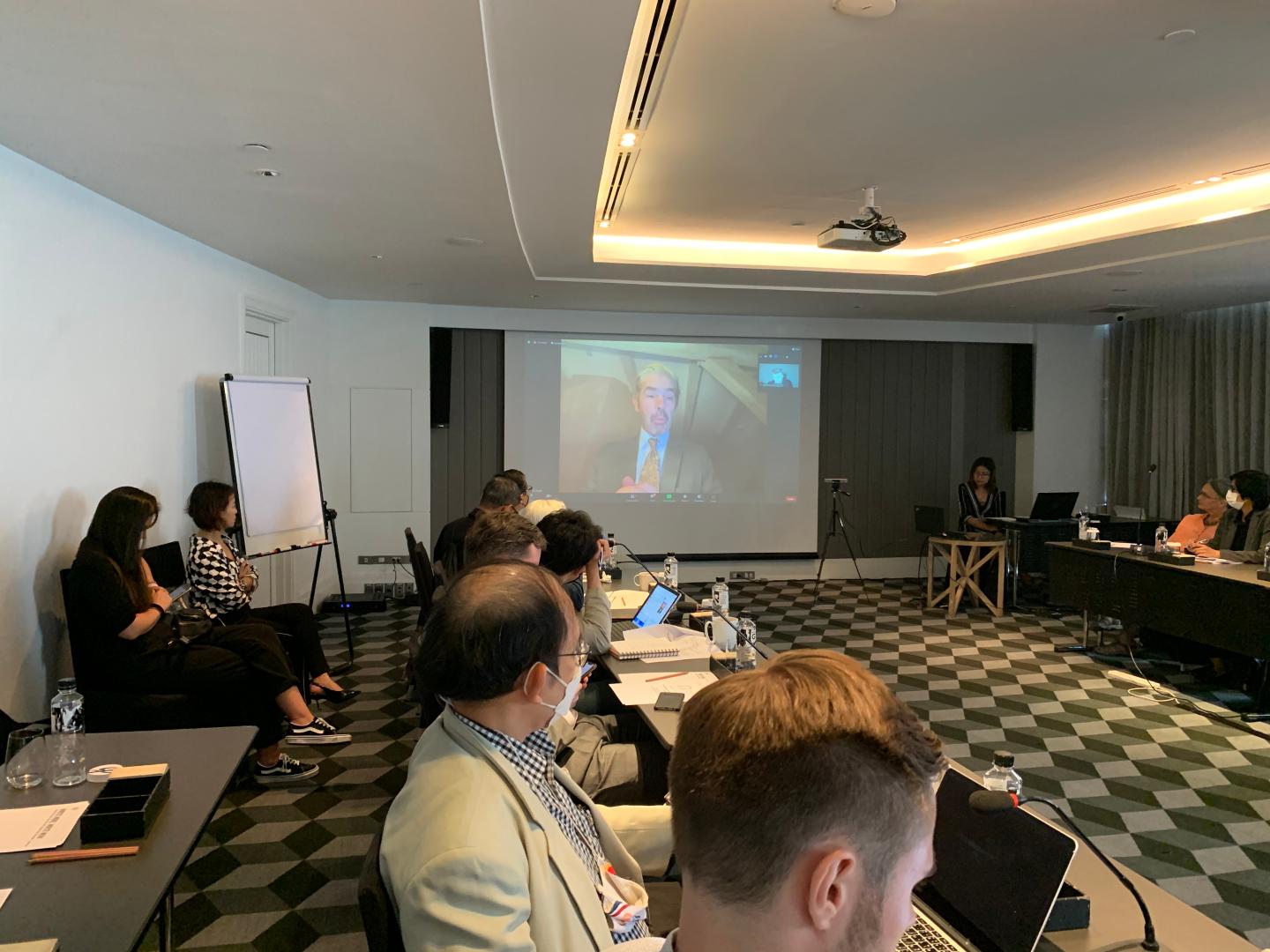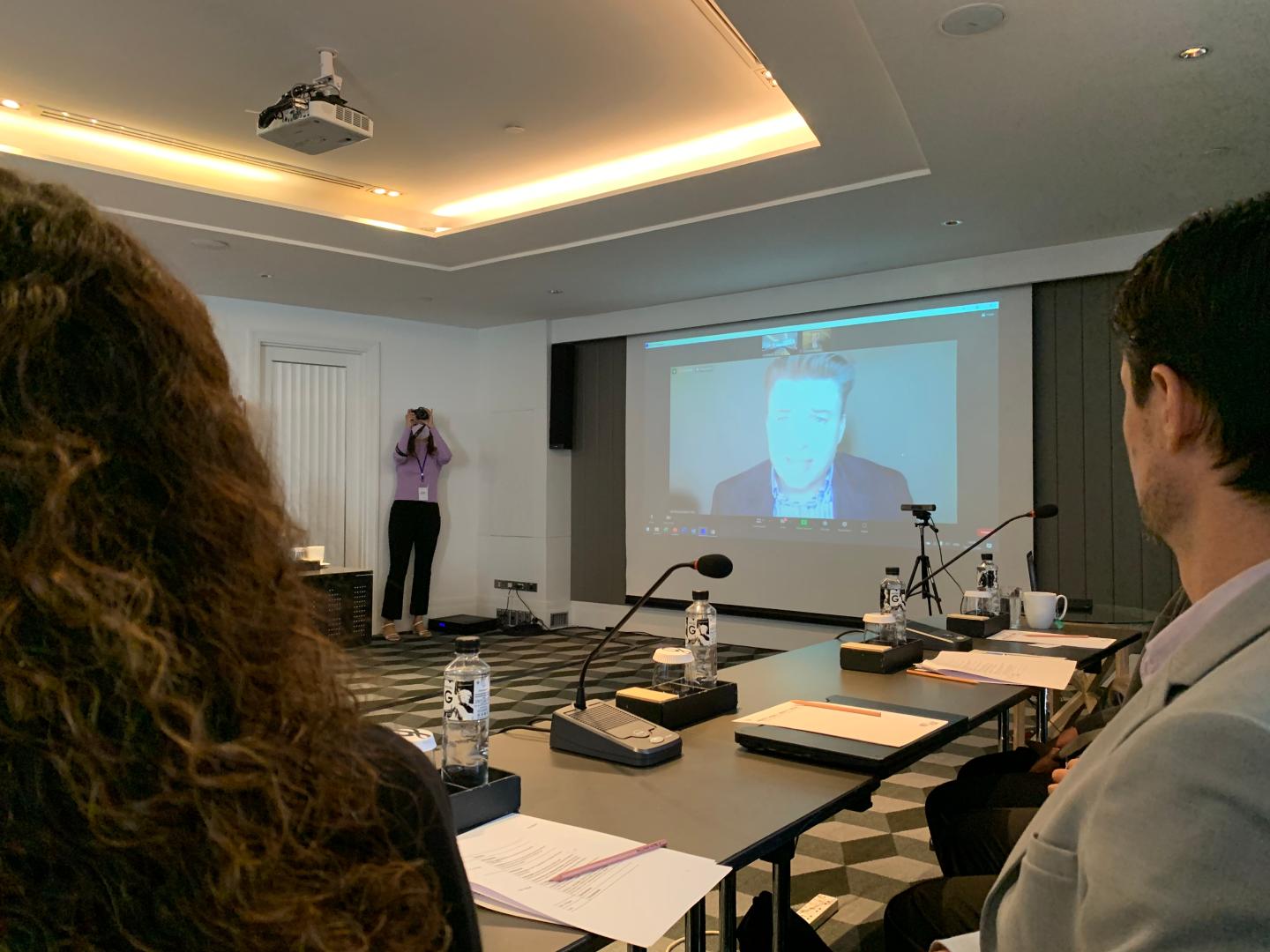รายงานกิจกรรม
Among the panellists were H.E. Kasit Piromya, former Foreign Minister of Thailand and CPG Senior Research Fellow; Antoine Ripoll, Director, Parliamentary Relations with ASEAN/Southeast Asia, DG External Policies, European Parliament; Associate Professor Dr. Natthanan Kunnamas, Jean Monet Chair Professor, Faculty of Political Science, Chulalongkorn University; Dr. Céline-Agathe Caro, Director of the KAS Office in Thailand; Henning Glaser, Director, CPG, Faculty of Law, Thammasat University, Thailand. Antoine Ripoll and Henning Glaser joined the event online from Strasbourg and Münster respectively.
The panel discussion opened with an assessment of the development of EU-ASEAN relations starting from the 1970s up to the present day. The account reached back to the time before the relations between the two blocs had been formalised and reflected on milestones of the constantly deepening relations between ASEAN and the then European Economic Community.
Driven by leadership, motivated by political will, and fostered by actions such as tariff measures, support for ASEAN in the participation in international trade fairs inter alia and the setting up of an ASEAN Trade Centre in Rotterdam, relations and mutual trust grew during a time in which both regional organisations underwent significant transformations. During the first decade of the new millennium, both the EU and ASEAN experienced a time of optimism that extended to the enhancement of their relations and suggested the EU as an example of regional integration that, if not a model for emulation, could significantly inspire ASEAN.
Then, in the 2010s, especially the EU was hit hard by the consequences of the 2008 global financial crisis, while both blocs faced the increasingly assertive rise of China. As the emerging great power struggle continues to shift the geopolitical environment fundamentally, EU-ASEAN relations are commanding notable interest. Currently, challenges on both sides and different regional priorities sometimes complicate the mostly flourishing EU-ASEAN relations on a political level while trade and economic relations have only grown importantly due to the pandemic and the consequences of great power rivalry.
On the part of the EU, the war in Ukraine has brought the urgency of war to Europe’s doorstep. As an end to the conflict remains out of sight, it was noted that this was likely to preoccupy the EU in terms of both its political and financial resources for years to come. On the side of the ASEAN, the territorial disputes in the South China Sea and the inability to act on the issue of the massive human rights violation of Myanmar’s post-coup government have shown the association’s weaknesses and the difficulty in maintaining its centrality in addressing the problems that face Southeast Asia as a whole. As an association that brings together a diverse spectrum from democratic to increasingly autocratic countries, the lack of a shared ideology remains a major hindrance for ASEAN. Because of this, ASEAN would continue to profit from external support to bridge the divides and move closer together. With the EU having to deal with multiple challenges to its security and economy, the question was raised if the EU will have the determination to help enhance ASEAN’s democratisation and to act as a committed partner in helping the association to avoid tough choices between the US and China.
The timely nature of the EU-ASEAN summit was affirmed, describing it as an important stepping-stone in further deepening the partnership. With the ASEAN Summits in Phnom Penh, the G20 in Bali and the APEC Leaders’ Summit in Bangkok, the summit in Brussels, which also included dedicated side events for the business community and youth, came at a time when multilateralism in Southeast Asia is showing strong momentum. This gives reason for confidence that the summit will build bridges towards further strengthened economic ties and continuing work in the spirit of the EU-Singapore and EU-Vietnam FTAs, with the long-term goal of reaching a comprehensive bloc-to-bloc EU-ASEAN FTA. Accompanying the deepening of economic interlinkages, the need to concomitantly intensify collaboration on climate action and sustainability was stressed, as this urgent crisis constitutes another unifying issue. The continued substantiation of the EU-ASEAN strategic partnership, which has been in place since 2020, was described as central and needs to be based on shared principles and common values, particularly the support for democracy and the respect for human rights. Contrary to doubts raised earlier in the discussion, confidence was expressed that the EU will not be too distracted with issues closer to home to make meaningful contributions to EU-ASEAN relations.
Elaborating on the question of which topics are likely to dominate the summit’s agenda, fear of China’s rise was noted as a common driver behind the EU-ASEAN cooperation. This commonality was qualified by noting the fundamentally different ways of engaging with this apprehension. Whereas the EU appears to be focusing on taking a common, supranational, and normatively shaped stance on China, ASEAN nations diverge strongly in their approaches towards China. Nations like Cambodia, Laos and Brunei are bandwagoning with Beijing to secure financial support, thereby obstructing collective decisions that follow the ASEAN Way of consensus finding. Other nations are more undecided, tilting either towards or away from China depending on the concrete issue under consideration. While they are also reliant on Chinese investments, issues such as the China’s unilateral actions on the water flows of the Mekong River complicate their relations. It was argued that this internal disunity of ASEAN complicates deepened cooperation between the regional blocs on sensitive issues and makes more technical fields of cooperation likely drivers of the relationship. Connectivity, trade, as well as rules-based issues like collaboration on IUU fishing were named as examples.
Based on the assessment that EU and ASEAN have common fears of China’s growing influence, it was stressed that this opens a window of opportunity based on trade and geostrategic synergies for the two blocs. While China’s influence is growing on every level, also with regards to soft power such as in academia and education, journalism and other areas, western powers continue to maintain the upper hand in important fields, such as total FDIs in the region. By noting that the growing great power rivalry has created a shared need for hedging and diversification in both the EU and the ASEAN, attention was brought to the fact that both regional blocs stand somewhat to the side of the US-PRC polarity and are hence attractive partners to each other. In particular, the EU’s emphasis on multilateralism sets it apart from the more assertive US. It was noted that the EU’s more nuanced approach has made it Southeast Asia´s most trusted partner in balancing against overdependence on China, according to the recent ISEAS State of Southeast Asia report.
Concurring with previous assessments that the EU-ASEAN relationship holds great potential, it was maintained that said potential remains starkly underutilized. This evaluation of the state and outlook of EU-ASEAN relations was contextualized by distinguishing four perspectives. In a contextual perspective, both regions are facing tectonic shifts in global conditions, severely challenging both in similar ways. The most pertinent contextual challenges, were summarized as the “5G”, consisting in the rolling back and reconfiguration of globalisation; the proliferation of global existential risks; a fraying global liberal order, the emergence of a geopolitical age and a progressively volatile great power struggle. Amid increasing fluidity of global and regional order and a resurgent primacy of security concerns over all others, the need and opportunity for both regional blocs to ensure an optimal reach and agency as responsible middle powers was emphasised. While great powers are increasingly locked in a cold-war-like competition, the EU and the ASEAN are in a good position to better manoeuvre the international system to jointly address global challenges such as climate change.
While the alignment of most of the blocs’ fundamental interests was noted, diverging opinions on the Russian war of aggression against a sovereign Ukraine imply the likely results of the summit will depend on the context under consideration. This suggests an overall productive meeting on trade, health, environmental and digital issues but makes a joint condemnation of Russia´s war against Ukraine unlikely. The war represents more than just the EU’s most urgent security threat as it is also a manifestation and driver of a multifaceted crisis of the world system as such.
From an institutional perspective, the lack of established mechanisms between the blocs, which number only two, is a hindrance for fulfilling the collaboration’s potential. Consequently, the hope was expressed that the summit might address this shortcoming by setting up more comprehensive institutional mechanisms.
The initial round of panellists’ statements concluded by contextualising the EU-ASEAN summit with the summit of the Eurasian Economic Union, the meeting between China and the Arab and Gulf states in Riyadh that happened almost simultaneously as well as current developments on an expanding BRICS, which might soon grow to include countries like Saudi-Arabia or Indonesia.
In the subsequent open forum, a number of participants voiced optimism for a further deepening of EU-ASEAN relations, citing the EU’s will and ability to be an attractive partner to the ASEAN despite the challenges outlined by the panellists. The urgency created by the multiple challenges was mentioned as a likely strong driver to catalyse joint action. The importance of finding emblematic projects that are suitable to raise the profile of the partnership was also acknowledged.
The confluence of interests that encompass broad areas of cooperation ranging from post-pandemic recovery over security cooperation to mutual support in the green energy transition was reaffirmed as main reason for confidence in the relationship. The recent visit of an ASEAN delegation to the EU as well as public statements by leading Members of the European Parliament were presented as clear evidence of political determination to foster action based on these shared incentives. The EU’s potential joining of the East Asia Summit as one option to open further venues of cooperation in the future was noted. Furthermore, the EU-ASEAN Plan of Action to implement the ASEAN-EU Strategic Partnership (2023-2027) was deemed promising, given adequate following-up to ensure it yields tangible initiatives.
A question drew attention to the social dimension of deepened EU-ASEAN cooperation and prompted a comment that stressed the ASEAN’s difficulties to find internal agreement on issues of social development as a main obstacle to successful partnerships in this sphere. Such incongruences would have to be surmounted first before an external partner such as the EU could come in and help. If such internal disagreements within the ASEAN are resolved, the EU with its long-standing commitment to the concerns of the underprivileged was commended as a good partner. In response to the same intervention, the EU’s vaccine and public health support that was extended to ASEAN nations during the height of the Covid-19 pandemic was recognised as an example of how EU engagement has already been benefiting the people in ASEAN.
Broadening the scope of considerations on non-security and non-trade cooperation, three suggestions for projects which would have the potential to substantially affect broad parts of the ASEAN’s societies indirectly while avoiding major points of disunity within ASEAN were outlined: (1) land-based connectivity projects, particularly on railways with a west-east corridor from Vietnam to India being a pertinent option; (2) water-based connectivity and coastal transformation; (3) relocation of manufacturing away from China and into Southeast Asia.
Another intervention raised the question of how the ASEAN should react in the face of increasing pressures to take sides between the US and China. In response, it was emphasised by some panellists that ASEAN leaders should clearly request the global powers to abstain from attempts to force ASEAN to take sides. Concerning the great power rivalry in the region, the relatively more positive perception of the US as an indispensable security provider among those increasingly worried about future Russian aggression or a violent unification of Taiwan and China was pointed out.
Reiterating the region’s concerns around the resilience of the EU’s engagement with the ASEAN, the question was raised whether the financial resources that the European Union and its individual member states are spending on the consequences of the War in Ukraine will draw budget away from new initiatives in Southeast Asia. In response, it was stressed that notwithstanding the urgency and costliness of addressing the impacts of the Russian invasion of Ukraine, the EU will have both the interest and the means to push for deepened cooperation with the ASEAN. As examples for ongoing EU initiatives, the European Green Deal, the EU Global Gateway, and the EU Strategic Compass were mentioned. With these projects offering venues for cooperation, the EU’s need to better communicate the scope and scale of its involvement in the region was noted, as in public perception that other actors such as Japan often outshine the EU.
Further deepening the question of EU funding for the ASEAN, the issue of how much of the EU funds are channelled to governmental organisations and how much is given directly to civil society organisations was raised. In response, it was pointed out that strict controls were in place to ensure the efficient and beneficial use of EU funds. Furthermore, the increasing number of EU projects offering direct access to EU funds to civil society organisations who apply successfully was noted.
Authors: Felix Jantz/Dr. Duc Quang Ly










